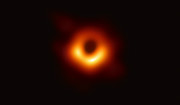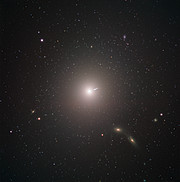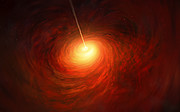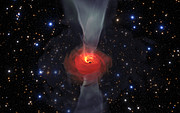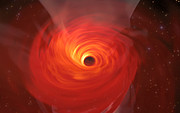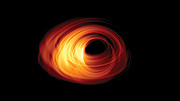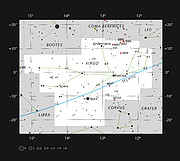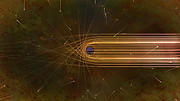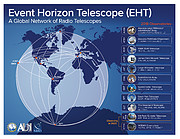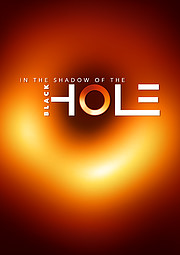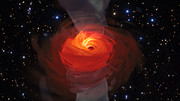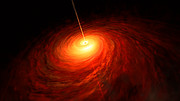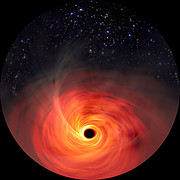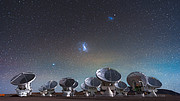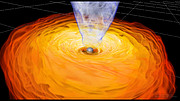Press Release
Astronomers Capture First Image of a Black Hole
ESO, ALMA, and APEX contribute to paradigm-shifting observations of the gargantuan black hole at the heart of the galaxy Messier 87
10 April 2019
The Event Horizon Telescope (EHT) — a planet-scale array of eight ground-based radio telescopes forged through international collaboration — was designed to capture images of a black hole. Today, in coordinated press conferences across the globe, EHT researchers reveal that they have succeeded, unveiling the first direct visual evidence of a supermassive black hole and its shadow.
This breakthrough was announced today in a series of six papers published in a special issue of The Astrophysical Journal Letters. The image reveals the black hole at the centre of Messier 87 [1], a massive galaxy in the nearby Virgo galaxy cluster. This black hole resides 55 million light-years from Earth and has a mass 6.5 billion times that of the Sun [2].
The EHT links telescopes around the globe to form an unprecedented Earth-sized virtual telescope [3]. The EHT offers scientists a new way to study the most extreme objects in the Universe predicted by Einstein’s general relativity during the centenary year of the historic experiment that first confirmed the theory [4].
"We have taken the first picture of a black hole," said EHT project director Sheperd S. Doeleman of the Center for Astrophysics | Harvard & Smithsonian. "This is an extraordinary scientific feat accomplished by a team of more than 200 researchers."
Black holes are extraordinary cosmic objects with enormous masses but extremely compact sizes. The presence of these objects affects their environment in extreme ways, warping spacetime and superheating any surrounding material.
"If immersed in a bright region, like a disc of glowing gas, we expect a black hole to create a dark region similar to a shadow — something predicted by Einstein’s general relativity that we’ve never seen before," explained chair of the EHT Science Council Heino Falcke of Radboud University, the Netherlands. "This shadow, caused by the gravitational bending and capture of light by the event horizon, reveals a lot about the nature of these fascinating objects and has allowed us to measure the enormous mass of M87’s black hole."
Multiple calibration and imaging methods have revealed a ring-like structure with a dark central region — the black hole’s shadow — that persisted over multiple independent EHT observations.
"Once we were sure we had imaged the shadow, we could compare our observations to extensive computer models that include the physics of warped space, superheated matter and strong magnetic fields. Many of the features of the observed image match our theoretical understanding surprisingly well," remarks Paul T.P. Ho, EHT Board member and Director of the East Asian Observatory [5]. "This makes us confident about the interpretation of our observations, including our estimation of the black hole’s mass."
"The confrontation of theory with observations is always a dramatic moment for a theorist. It was a relief and a source of pride to realise that the observations matched our predictions so well," elaborated EHT Board member Luciano Rezzolla of Goethe Universität, Germany.
Creating the EHT was a formidable challenge which required upgrading and connecting a worldwide network of eight pre-existing telescopes deployed at a variety of challenging high-altitude sites. These locations included volcanoes in Hawai`i and Mexico, mountains in Arizona and the Spanish Sierra Nevada, the Chilean Atacama Desert, and Antarctica.
The EHT observations use a technique called very-long-baseline interferometry (VLBI) which synchronises telescope facilities around the world and exploits the rotation of our planet to form one huge, Earth-size telescope observing at a wavelength of 1.3mm. VLBI allows the EHT to achieve an angular resolution of 20 micro-arcseconds — enough to read a newspaper in New York from a café in Paris [6].
The telescopes contributing to this result were ALMA, APEX, the IRAM 30-meter telescope, the James Clerk Maxwell Telescope, the Large Millimeter Telescope Alfonso Serrano, the Submillimeter Array, the Submillimeter Telescope, and the South Pole Telescope [7]. Petabytes of raw data from the telescopes were combined by highly specialised supercomputers hosted by the Max Planck Institute for Radio Astronomy and MIT Haystack Observatory.
European facilities and funding played a crucial role in this worldwide effort, with the participation of advanced European telescopes and the support from the European Research Council — particularly a €14 million grant for the BlackHoleCam project [8]. Support from ESO, IRAM and the Max Planck Society was also key. "This result builds on decades of European expertise in millimetre astronomy”, commented Karl Schuster, Director of IRAM and member of the EHT Board.
The construction of the EHT and the observations announced today represent the culmination of decades of observational, technical, and theoretical work. This example of global teamwork required close collaboration by researchers from around the world. Thirteen partner institutions worked together to create the EHT, using both pre-existing infrastructure and support from a variety of agencies. Key funding was provided by the US National Science Foundation (NSF), the EU's European Research Council (ERC), and funding agencies in East Asia.
“ESO is delighted to have significantly contributed to this result through its European leadership and pivotal role in two of the EHT’s component telescopes, located in Chile — ALMA and APEX,” commented ESO Director General Xavier Barcons. “ALMA is the most sensitive facility in the EHT, and its 66 high-precision antennas were critical in making the EHT a success.”
"We have achieved something presumed to be impossible just a generation ago," concluded Doeleman. "Breakthroughs in technology, connections between the world's best radio observatories, and innovative algorithms all came together to open an entirely new window on black holes and the event horizon.”
Notes
[1] The shadow of a black hole is the closest we can come to an image of the black hole itself, a completely dark object from which light cannot escape. The black hole’s boundary — the event horizon from which the EHT takes its name — is around 2.5 times smaller than the shadow it casts and measures just under 40 billion km across.
[2] Supermassive black holes are relatively tiny astronomical objects — which has made them impossible to directly observe until now. As the size of a black hole’s event horizon is proportional to its mass, the more massive a black hole, the larger the shadow. Thanks to its enormous mass and relative proximity, M87’s black hole was predicted to be one of the largest viewable from Earth — making it a perfect target for the EHT.
[3] Although the telescopes are not physically connected, they are able to synchronize their recorded data with atomic clocks — hydrogen masers — which precisely time their observations. These observations were collected at a wavelength of 1.3 mm during a 2017 global campaign. Each telescope of the EHT produced enormous amounts of data – roughly 350 terabytes per day – which was stored on high-performance helium-filled hard drives. These data were flown to highly specialised supercomputers — known as correlators — at the Max Planck Institute for Radio Astronomy and MIT Haystack Observatory to be combined. They were then painstakingly converted into an image using novel computational tools developed by the collaboration.
[4] 100 years ago, two expeditions set out for Principe Island off the coast of Africa and Sobral in Brazil to observe the 1919 solar eclipse, with the goal of testing general relativity by seeing if starlight would be bent around the limb of the sun, as predicted by Einstein. In an echo of those observations, the EHT has sent team members to some of the world's highest and most isolated radio facilities to once again test our understanding of gravity.
[5] The East Asian Observatory (EAO) partner on the EHT project represents the participation of many regions in Asia, including China, Japan, Korea, Taiwan, Vietnam, Thailand, Malaysia, India and Indonesia.
[6] Future EHT observations will see substantially increased sensitivity with the participation of the IRAM NOEMA Observatory, the Greenland Telescope and the Kitt Peak Telescope.
[7] ALMA is a partnership of the European Southern Observatory (ESO; Europe, representing its member states), the U.S. National Science Foundation (NSF), and the National Institutes of Natural Sciences(NINS) of Japan, together with the National Research Council (Canada), the Ministry of Science and Technology (MOST; Taiwan), Academia Sinica Institute of Astronomy and Astrophysics (ASIAA; Taiwan), and Korea Astronomy and Space Science Institute (KASI; Republic of Korea), in cooperation with the Republic of Chile. APEX is operated by ESO, the 30-meter telescope is operated by IRAM (the IRAM Partner Organizations are MPG (Germany), CNRS (France) and IGN (Spain)), the James Clerk Maxwell Telescope is operated by the EAO, the Large Millimeter Telescope Alfonso Serrano is operated by INAOE and UMass, the Submillimeter Array is operated by SAO and ASIAA and the Submillimeter Telescope is operated by the Arizona Radio Observatory (ARO). The South Pole Telescope is operated by the University of Chicago with specialized EHT instrumentation provided by the University of Arizona.
[8] BlackHoleCam is an EU-funded project to image, measure and understand astrophysical black holes. The main goal of BlackHoleCam and the Event Horizon Telescope (EHT) is to make the first ever images of the billion solar masses black hole in the nearby galaxy M87 and of its smaller cousin, Sagittarius A*, the supermassive black hole at the centre of our Milky Way. This allows the determination of the deformation of spacetime caused by a black hole with extreme precision.
More information
This research was presented in a series of six papers published today in a special issue of The Astrophysical Journal Letters.
The EHT collaboration involves more than 200 researchers from Africa, Asia, Europe, North and South America. The international collaboration is working to capture the most detailed black hole images ever by creating a virtual Earth-sized telescope. Supported by considerable international investment, the EHT links existing telescopes using novel systems — creating a fundamentally new instrument with the highest angular resolving power that has yet been achieved.
The individual telescopes involved are; ALMA, APEX, the IRAM 30-meter Telescope, the IRAM NOEMA Observatory, the James Clerk Maxwell Telescope (JCMT), the Large Millimeter Telescope (LMT), the Submillimeter Array (SMA), the Submillimeter Telescope (SMT), the South Pole Telescope (SPT), the Kitt Peak Telescope, and the Greenland Telescope (GLT).
The EHT consortium consists of 13 stakeholder institutes; the Academia Sinica Institute of Astronomy and Astrophysics, the University of Arizona, the University of Chicago, the East Asian Observatory, Goethe-Universitaet Frankfurt, Institut de Radioastronomie Millimétrique, Large Millimeter Telescope, Max Planck Institute for Radio Astronomy, MIT Haystack Observatory, National Astronomical Observatory of Japan, Perimeter Institute for Theoretical Physics, Radboud University and the Smithsonian Astrophysical Observatory.
ESO is the foremost intergovernmental astronomy organisation in Europe and the world’s most productive ground-based astronomical observatory by far. It has 16 Member States: Austria, Belgium, Czechia, Denmark, France, Finland, Germany, Ireland, Italy, the Netherlands, Poland, Portugal, Spain, Sweden, Switzerland and the United Kingdom, along with the host state of Chile and with Australia as a Strategic Partner. ESO carries out an ambitious programme focused on the design, construction and operation of powerful ground-based observing facilities enabling astronomers to make important scientific discoveries. ESO also plays a leading role in promoting and organising cooperation in astronomical research. ESO operates three unique world-class observing sites in Chile: La Silla, Paranal and Chajnantor. At Paranal, ESO operates the Very Large Telescope and its world-leading Very Large Telescope Interferometer as well as two survey telescopes, VISTA working in the infrared and the visible-light VLT Survey Telescope. Also at Paranal ESO will host and operate the Cherenkov Telescope Array South, the world’s largest and most sensitive gamma-ray observatory. ESO is also a major partner in two facilities on Chajnantor, APEX and ALMA, the largest astronomical project in existence. And on Cerro Armazones, close to Paranal, ESO is building the 39-metre Extremely Large Telescope, the ELT, which will become “the world’s biggest eye on the sky”.
Links
- ESO EHT web page
- Invitation for media to the press conference
- EHT Website & Press Release
- ESOBlog on the EHT Project
- Images of ALMA
- Images of APEX
- EHT comic by NAOJ (PDF format, 39,1 MB)
- Papers:
- Paper I: The Shadow of the Supermassive Black Hole
- Paper II: Array and Instrumentation
- Paper III: Data processing and Calibration
- Paper IV: Imaging the Central Supermassive Black Hole
- Paper V: Physical Origin of the Asymmetric Ring
- Paper VI: The Shadow and Mass of the Central Black Hole
Contacts
Heino Falcke
Chair of the EHT Science Council, Radboud University
The Netherlands
Tel: +31 24 3652020
Email: h.falcke@astro.ru.nl
Luciano Rezzolla
EHT Board Member, Goethe Universität
Germany
Tel: +49 69 79847871
Email: rezzolla@itp.uni-frankfurt.de
Eduardo Ros
EHT Board Secretary, Max-Planck-Institut für Radioastronomie
Germany
Tel: +49 22 8525125
Email: ros@mpifr.de
Calum Turner
ESO Public Information Officer
Garching bei München, Germany
Tel: +49 89 3200 6670
Email: pio@eso.org
About the Release
| Release No.: | eso1907 |
| Name: | M87*, Messier 87 |
| Type: | Local Universe : Galaxy : Component : Central Black Hole |
| Facility: | Atacama Large Millimeter/submillimeter Array, Atacama Pathfinder Experiment, Event Horizon Telescope |


